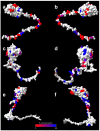Burkholderia pseudomallei Complex Subunit and Glycoconjugate Vaccines and Their Potential to Elicit Cross-Protection to Burkholderia cepacia Complex
- PMID: 38543947
- PMCID: PMC10975474
- DOI: 10.3390/vaccines12030313
Burkholderia pseudomallei Complex Subunit and Glycoconjugate Vaccines and Their Potential to Elicit Cross-Protection to Burkholderia cepacia Complex
Abstract
Burkholderia are a group of Gram-negative bacteria that can cause a variety of diseases in at-risk populations. B. pseudomallei and B. mallei, the etiological agents of melioidosis and glanders, respectively, are the two clinically relevant members of the B. pseudomallei complex (Bpc). The development of vaccines against Bpc species has been accelerated in recent years, resulting in numerous promising subunits and glycoconjugate vaccines incorporating a variety of antigens. However, a second group of pathogenic Burkholderia species exists known as the Burkholderia cepacia complex (Bcc), a group of opportunistic bacteria which tend to affect individuals with weakened immunity or cystic fibrosis. To date, there have been few attempts to develop vaccines to Bcc species. Therefore, the primary goal of this review is to provide a broad overview of the various subunit antigens that have been tested in Bpc species, their protective efficacy, study limitations, and known or suspected mechanisms of protection. Then, we assess the reviewed Bpc antigens for their amino acid sequence conservation to homologous proteins found in Bcc species. We propose that protective Bpc antigens with a high degree of Bpc-to-Bcc sequence conservation could serve as components of a pan-Burkholderia vaccine capable of protecting against both disease-causing groups.
Keywords: Burkholderia cepacia complex; Burkholderia mallei; Burkholderia pseudomallei; cystic fibrosis; glanders; glycoconjugate; melioidosis; subunit; vaccines.
Conflict of interest statement
The authors declare no conflicts of interest.
Figures



Similar articles
-
Current Advances in Burkholderia Vaccines Development.Cells. 2020 Dec 11;9(12):2671. doi: 10.3390/cells9122671. Cells. 2020. PMID: 33322641 Free PMC article. Review.
-
Development of Burkholderia mallei and pseudomallei vaccines.Front Cell Infect Microbiol. 2013 Mar 11;3:10. doi: 10.3389/fcimb.2013.00010. eCollection 2013. Front Cell Infect Microbiol. 2013. PMID: 23508691 Free PMC article. Review.
-
Burkholderia vaccines: are we moving forward?Front Cell Infect Microbiol. 2013 Feb 5;3:5. doi: 10.3389/fcimb.2013.00005. eCollection 2013. Front Cell Infect Microbiol. 2013. PMID: 23386999 Free PMC article. Review.
-
Recombinant Salmonella Expressing Burkholderia mallei LPS O Antigen Provides Protection in a Murine Model of Melioidosis and Glanders.PLoS One. 2015 Jul 6;10(7):e0132032. doi: 10.1371/journal.pone.0132032. eCollection 2015. PLoS One. 2015. PMID: 26148026 Free PMC article.
-
In Vitro Antibacterial Activity and In Vivo Efficacy of Sulbactam-Durlobactam against Pathogenic Burkholderia Species.Antimicrob Agents Chemother. 2021 Feb 17;65(3):e01930-20. doi: 10.1128/AAC.01930-20. Print 2021 Feb 17. Antimicrob Agents Chemother. 2021. PMID: 33318017 Free PMC article.
Cited by
-
Evaluation of Highly Conserved Burkholderia pseudomallei Outer Membrane Proteins as Protective Antigens Against Respiratory Melioidosis.Res Sq [Preprint]. 2025 May 13:rs.3.rs-6549424. doi: 10.21203/rs.3.rs-6549424/v1. Res Sq. 2025. Update in: NPJ Vaccines. 2025 Aug 6;10(1):186. doi: 10.1038/s41541-025-01246-2. PMID: 40470231 Free PMC article. Updated. Preprint.
-
Surface-Exposed Protein Moieties of Burkholderia cenocepacia J2315 in Microaerophilic and Aerobic Conditions.Vaccines (Basel). 2024 Apr 9;12(4):398. doi: 10.3390/vaccines12040398. Vaccines (Basel). 2024. PMID: 38675780 Free PMC article.
-
Evaluation of highly conserved Burkholderia pseudomallei outer membrane proteins as protective antigens against respiratory melioidosis.NPJ Vaccines. 2025 Aug 6;10(1):186. doi: 10.1038/s41541-025-01246-2. NPJ Vaccines. 2025. PMID: 40770240 Free PMC article.
-
Immune responses following DNA vaccination by needle-free injection against Burkholderia pseudomallei hemolysin co-regulated protein 1.Front Immunol. 2025 Jun 25;16:1612540. doi: 10.3389/fimmu.2025.1612540. eCollection 2025. Front Immunol. 2025. PMID: 40636117 Free PMC article.
References
-
- Center for Disease Control and Prevention. [(accessed on 11 November 2023)]; Available online: https://www.selectagents.gov/sat/list.htm.
-
- Limmathurotsakul D., Golding N., Dance D.A.B., Messina J.P., Pigott D.M., Moyes C.L., Rolim D.B., Bertherat E., Day N.P.J., Peacock S.J., et al. Predicted global distribution of Burkholderia pseudomallei and burden of melioidosis. Nat. Microbiol. 2016;1:15008. doi: 10.1038/nmicrobiol.2015.8. - DOI - PubMed
Publication types
Grants and funding
LinkOut - more resources
Full Text Sources
Molecular Biology Databases

